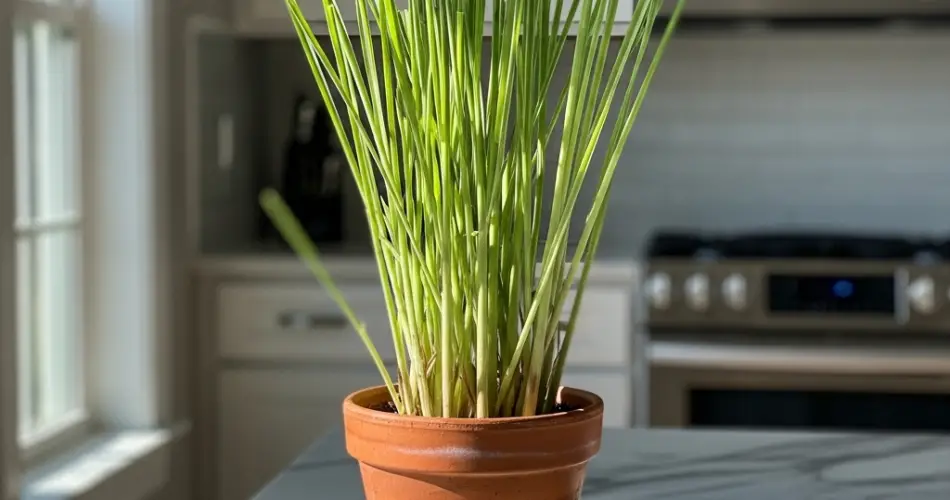Lemongrass is a fragrant and versatile herb widely used in cooking, teas, and natural remedies. Its fresh, citrusy flavor enhances soups, curries, and stir-fries, while its leaves and stalks can be brewed into soothing beverages. While lemongrass is often grown outdoors in warm climates, it is surprisingly adaptable to indoor cultivation, making it an ideal herb for kitchen planters. Growing lemongrass indoors allows gardeners to enjoy fresh, aromatic stalks year-round without the need for a backyard.
Selecting the Right Lemongrass
When choosing lemongrass for indoor planting, opt for fresh stalks from the grocery store or a nursery that still have a base of roots or nodes. Look for firm, healthy stalks with vibrant green leaves and a slightly swollen base. Avoid dried or wilted stalks, as these are less likely to produce new growth. Using stalks with an intact base increases the chances of successful root development.
Choosing Containers for Indoor Growth
Lemongrass develops long roots and thrives in deep containers. A pot at least 12 inches deep and wide is ideal for indoor growth. Ensure the planter has drainage holes to prevent waterlogging, which can damage the roots. Terra cotta or ceramic pots are excellent options because they allow air to circulate through the soil, but any well-draining container will suffice. A wide planter is also beneficial because lemongrass spreads, and extra space allows multiple stalks to grow together.
Preparing Soil for Lemongrass
Lemongrass prefers loose, nutrient-rich soil that drains well. A mixture of potting soil, sand, and compost creates an ideal medium. Avoid compacted soils that restrict root expansion or retain too much moisture. Mixing in organic fertilizer at the time of planting supports healthy root and leaf growth. The slightly acidic to neutral pH range of 6.0–7.0 is optimal for lemongrass.
Planting Lemongrass in Planters
To plant lemongrass, trim the stalks to leave about 3–4 inches of the base. Remove any wilted outer leaves and cut the tops if they are too long, leaving enough foliage to support photosynthesis. Place the stalks in soil with the base covered while keeping the remaining leaves above the soil. If planting multiple stalks in one container, space them about 2–3 inches apart to allow for growth and airflow.
Water thoroughly after planting to settle the soil around the roots. Keep the soil consistently moist but not soggy during the initial weeks to encourage root development.
Light and Temperature Requirements
Lemongrass thrives in bright, indirect sunlight. Place your planter near a sunny kitchen window, ideally receiving at least 6–8 hours of light per day. If natural light is insufficient, supplement with a grow light to maintain healthy growth. Lemongrass prefers warm conditions, with indoor temperatures between 70–85°F (21–29°C). Avoid cold drafts or placing the planter near heating vents, as extreme temperature changes can stress the plant.
Watering and Maintenance
Water lemongrass regularly to keep the soil slightly moist, particularly during active growth. Indoor planters tend to dry out faster than garden beds, so monitor the soil closely. Fertilize every 3–4 weeks with a balanced, water-soluble fertilizer to provide nutrients that may be depleted in container soil.
Trim yellowing or damaged leaves to maintain plant health and encourage new growth. Regular pruning also helps the plant stay compact and manageable indoors.
Harvesting Lemongrass
You can begin harvesting lemongrass once stalks reach at least 12 inches in height and the base is thickened. Cut stalks near the soil line, leaving some leaves intact to allow continued growth. Frequent harvesting encourages fresh growth and ensures a steady supply of stalks for cooking or tea. Leaves can also be used for flavoring soups and broths, adding extra versatility to your indoor herb garden.
Common Challenges
Indoor lemongrass is generally easy to grow, but issues may arise if the plant is overwatered, receives insufficient light, or is exposed to extreme temperatures. Ensure proper drainage, monitor soil moisture, and provide adequate light to prevent these problems. Occasionally, pests such as aphids may appear; treat infestations promptly using organic methods like neem oil or insecticidal soap.
Benefits of Indoor Lemongrass
Growing lemongrass indoors provides fresh, aromatic herbs at your fingertips while saving trips to the store. Its strong fragrance adds a pleasant scent to your kitchen, and its versatility in cooking and beverages makes it an indispensable herb. Indoor cultivation is especially beneficial for those without a backyard, turning kitchen counters and windowsills into productive green spaces.
Conclusion
Lemongrass is an excellent choice for indoor kitchen gardening. By selecting healthy stalks, providing well-draining soil, maintaining consistent watering, and ensuring adequate light, you can enjoy a continuous supply of fresh, aromatic lemongrass year-round. Even in small spaces, indoor planters make it possible to grow this flavorful herb, combining practicality, sustainability, and the delight of homegrown freshness.



